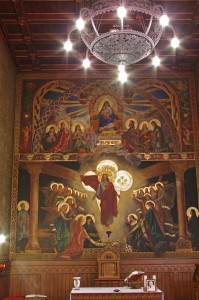Located on the third and fourth floors of the west wing of the building, facing onto the street, is the chapel. Appropriate to the era, the simple rectangular plan chapel with its two blocks of benches and lack of side aisles, with altar, pulpit, gallery and wood panelled ceiling was decorated in Art Nouveau and historicist style. Light streams from the east through four large and one small circular stained-glass windows.
The chapel is dedicated to the Sacred Heart of Jesus. Both Pope Leo XIII’s decision to declare 1900 as The Year of the Sacred Heart of Jesus and the intimate connection with priestly formation were the inspirations for this dedication. In the upper part of the horizontally divided sanctuary wall, in the centre, on a high throne, sits Our Lady of Hungary. In front of Her on the right, King Saint Stephen, offering his crown, with Prince Saint Imre and Saint László. On the left, kneeling, St. Elisabeth, St. Gellért and St. Margit. Under the throne, “Patrona Hungariae ora pro nobis!” – Our Lady of Hungary pray for us! In the upper corners can be seen the double cross set on the trimount from the Hungarian coat of arms and the three ostrich feathers, the emblem of the founder, Péter Pázmány. In the lower picture, which somewhat dominates the sanctuary and the chapel, can be seen the floating figure of Christ, surrounded by golden rays of light, indicating his heart, and in the company of angels holding the instruments of his torture. In the picture a scroll winds its way around the figures: “0 cor amoris victima caeli perenne gaudium – discite a me quia mitis sum et humilis corde – mortalium solatium mortalium spes ultima” – Oh loving heart, heavenly sacrifice, eternal joy – learn from me, for I am meek and humble of heart – the solace and last hope of mortal men.” The apparition is bordered on both sides by a Roman column, on the far side of which, on the left, is the Jesuit St. Aloysius Gonzaga and on the right, a kneeling sister of the Visitation order, St. Margaret Mary Alacoque. They both contributed greatly to the modern devotion to the cult of the Sacred Heart of Jesus and to its propagation. Traditionally, some of the angels in the lower picture and the child angels in the upper picture bear the facial features of members of the Széchenyi family. The artist, according to the signature in the bottom right hand corner of the fresco, was Erzsébet Angyalffy, born in Pécs in 1861. In the years 1877-78 and 1881-82 she was a student of the National Art and Teacher Training Institute in Budapest under Bertalan Székely, and later Károly Lotz.
The choir loft of the chapel functions as an oratory. Here stands the Rococo altar which was the high altar of the old Pazmaneum chapel, and which, according to the archives, Bálint Seredy, general practitioner to the Pazmaneum had erected at his own expense in 1773 in gratitude to the College. The pink marbled altar superstructure is framed on both sides by a composite headed column, and above closed by a high curved architrave. Its gold-plated wood carvings, the frame of the altarpiece and the two reliquaries standing on the mensa are of good quality Rococo work. The altarpiece depicts Our Lady of the Snows, based on the devotional painting in Santa Maria Maggiore in Rome. Following the reordering of the sanctuary in 1980 in the spirit of the Second Vatican Council, the tabernacle, also part of the original furnishings, stood for a long time in the left-hand corner, with the priest’s seat in the middle. In 2011, the original ordering was restored, i.e. the tabernacle was repositioned in the centre, whilst leaving in place the altar facing the people.
